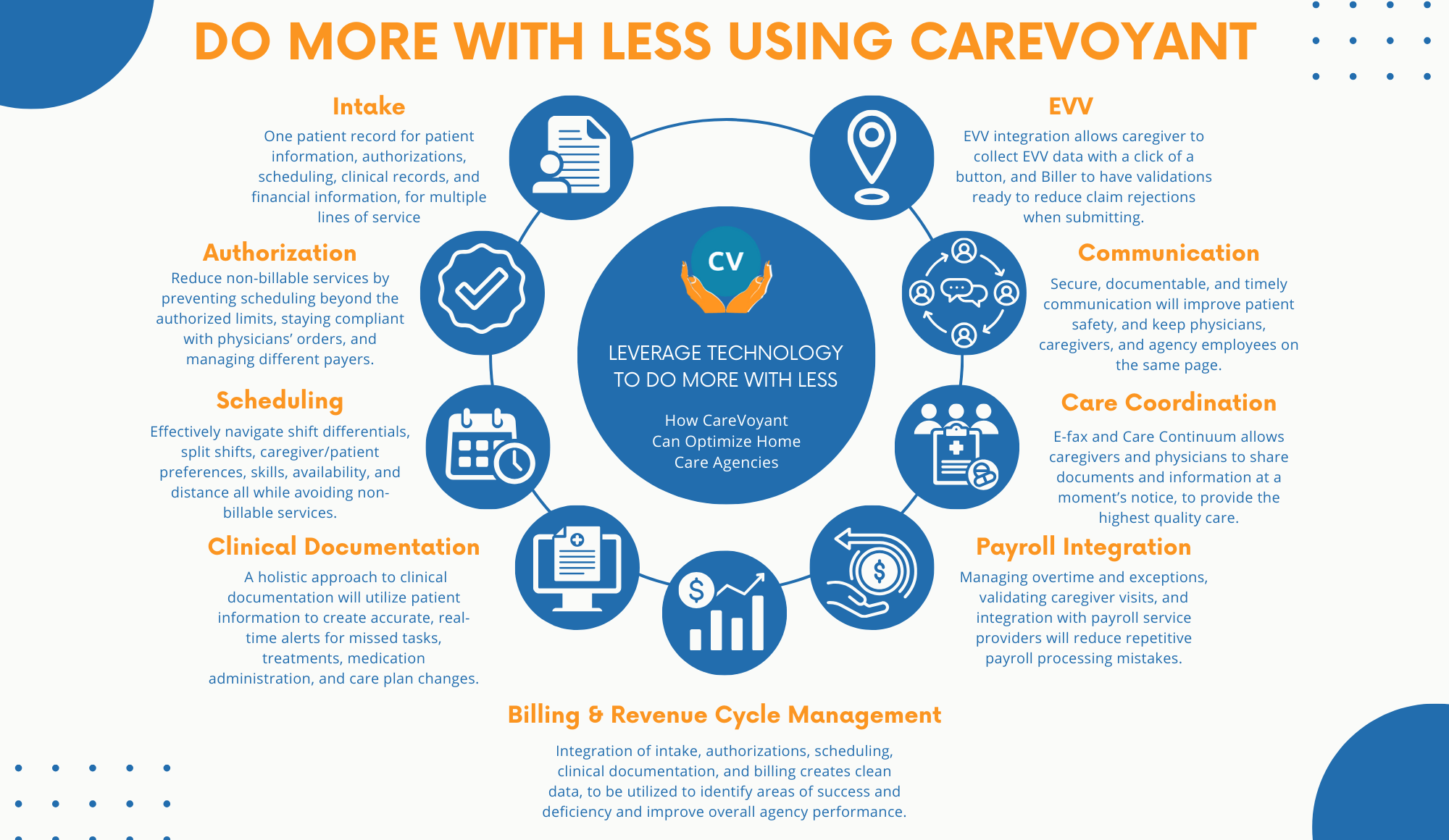By Monica Pasupathy
Discover the art of doing more with less in Home Care agencies through technology-driven strategies. Enhance your agency's capabilities and efficiency in patient care.
This blog will discuss how technology can be a game-changer for home care agencies, enabling them to achieve more with fewer resources.
Introduction
Home Care services allow patients to continue comfortably living in their own home while they receive personal or medical care. From fall prevention to occupational therapy, from medication administration to companionship, Home Care services allow people who can’t fully take care of themselves to manage their illnesses, which allows them to live more independently.
Home Care agencies, whether they provide one or more home care services, face a large array of challenges, as the Home Care industry can be fluid and volatile. Consistent staffing challenges, expanding regulatory requirements, inconsistent funding, and complex agency operations are just some out of the many challenges they face, and some agencies can become quickly overwhelmed when any one of these problems rear their heads.
Leveraging technology can help home care agencies minimize these challenges. Home Care Software that supports multiple lines of service, is configurable and scalable, and issues proactive alerts, will help support compliance and optimize all agency operations. The right Home Care Software can integrate and optimize home care agencies from Intake and Authorization, all the way through Billing and reimbursement.
Intake
Home Care Software that combines Intake and Authorization management helps streamline the agency. Home Care Software should be able to collect the patient’s information in one place: one screen should include patient information, authorizations, scheduling, clinical records, and financial information under one patient record, for multiple lines of service. Home Care Software should have configurable intake validations to help the intake team proactively identify missing information before they become billing and reimbursement issues. Home Care Software, with built-in validations, will help the agencies to get a head start in Revenue Cycle Management.
Authorization
An integrated authorization function built into the Home Care Software will improve compliance overall. It can help an agency reduce non-billable services by preventing scheduling beyond the authorized limits; it can help caregivers stay compliant with physicians’ orders and authorizations; and it can manage insurance, Medicaid, and managed care service authorizations. Improving agency compliance will eventually improve quality of care, patient satisfaction, and the agency’s bottom line.
Scheduling
Scheduling can become messy quickly when not aided by the right Home Care Software. Between shift differentials, split shifts, and overtime management, a scheduler also must consider caregiver preferences, skills, availability, and distance. Efficient Home Care Software with intelligent matching should manage all of this in one screen and create a pool of eligible caregivers who match pre-set requirements during the scheduling process.
The right Home Care Software will efficiently manage scheduling, but should also integrate scheduling with proactive alerts, clinical information, point of care, billing, and payroll. These integrations will reduce mistakes made in patient data collection, improving the billing process down the line and improving the agency’s operational efficiency.
Clinical Documentation & POC
Collecting patient information and clinical notes is important; however, every clinician would rather spend more time caring for their patient than logging the information. Software that allows the clinician to spend more time with their patient whilst ensuring the correct data is collected will improve caregiver and patient satisfaction. An agency that uses home care software that compiles patient information and employee tasks in one screen allows its clinicians to provide the highest quality care they can and will retain more patients later.
Beyond this, Home Care Software should follow the clinician’s plan of care. Not only should all patient information be found on one screen, but the software should be able to pull patient information from different lines of service. Creating a holistic view of the patient on one screen allows the clinician to receive every bit of relevant information without the tedium of clicking in and out of multiple screens. Home Care Software that takes a holistic approach will also be able to use all the information on the patient to create accurate, real-time alerts for missed tasks, treatments, medication administration, and care plan changes. Configurable consistency checks and proactive alerts will improve the quality of the clinical documentation significantly reducing potential survey issues.
EVV (Electronic Visit Verification)
One of the newer regulations in the home care industry is Electronic Visit Verification (EVV). This requires the caregiver to “check in” at the start of the visit, using geolocation to collect both time and place of the visit. While this regulation is useful for agencies, caregivers, patients, and regulators alike, it amounts to added time, cost, and labor for the agencies and caregivers.
The right Home Care Software will include EVV in its platform and allow the caregiver to collect all EVV data with a click of a button at the start of the visit. Moreover, EVV collection should be within the same home care software where the caregiver will be creating clinical documents, instead of having to use different software for different purposes.
Finally, the full integration of EVV in Home Care Software should include EVV validations by the time the billing occurs to reduce claim rejections and time spent resubmitting rejected claims.
Billing & Revenue Cycle Management
The pressure that home care agencies are under to do more with less is felt most acutely when the care process reaches the billing stage. An ineffective billing process can negatively affect prompt billing, quick reimbursement time, cash flow, and agency bottom line. Home Care Software that is integrated from intake all the way to billing, with authorization notifications and alerts throughout, will minimize claims rejections.
The software should be able to automatically handle disparate billing requirements for Medicare, Medicaid, waiver programs, private pay, and insurance. It should also give the biller the ability to customize validations by payer and use reports to prevent claims from being sent out without the right authorization and documentation.
The right Home Care Software for an agency hoping to improve its bottom line will include accessible reports and dashboards that analyze the agency’s overall financial performance. The integration of everything – intake, authorizations, scheduling, clinical documentation, and billing – will all add up into clean and actionable data that the home care agency can use to identify areas of success and deficiency and improve overall agency performance.
Payroll Integration
Home care companies, still facing the issue of low caregiver retention, have high incentive to keep employees satisfied. One of the biggest factors in employee satisfaction is prompt and accurate payroll. Home Care Software should reduce the time spent on processing payroll. By managing overtime and exceptions, validating caregiver visits, and integrating with payroll service providers, the right Home Care Software will help home care agencies efficiently process payroll, reduce burden on employees, and improve employee satisfaction.
Communication
With so many teams within home care agencies, and all teams needing to work smoothly together to keep the ball rolling, easy and secure communication is vital to operational efficiency. The right Home Care Software will include communication tools between agency employees, caregivers and patients.
Home care software should have portals where HIPAA (Health Insurance Portability and Accountability) compliant messaging between employees and patients can take place; this communication should be documentable, only to be sent to the relevant agency team members, to keep the patient’s information secure. Real-time clinical communication and schedule notifications available to both caregiver and patient should also be included. The right home care software that provides all of this will keep everyone on the same page and improve the quality of care, alongside employee and patient satisfaction. Most importantly, secure, documentable, and prompt communication will improve patient safety.
Care Coordination
Beyond internal communication, the right Home Care Software should have the tools to improve care coordination. By including an e-Fax function, making it easy to send relevant documentation to an external care team, physicians’ orders will be followed, and the plan of care can be updated when it changes. When more urgent communication is necessary, a direct messaging function built into the software that allows the caregiver to reach out to a physician or patient at a moment’s notice can improve patient safety and quality of care.
Frequently Asked Questions
-
Technology helps home care agencies streamline operations, improve compliance, reduce administrative burdens, and enhance patient care while managing staffing challenges and regulatory requirements.
-
Home care software integrates intake and authorization management, reducing errors, ensuring compliance, and preventing non-billable services by validating patient information upfront.
-
Home care software for scheduling features allow agencies to match caregivers based on skills, availability, and patient needs, while managing overtime and shift differentials in real time.
-
EVV ensures compliance with regulations by verifying caregiver visits through geolocation, reducing fraud, improving accuracy, and minimizing claim rejections.
-
Integrated clinical documentation ensures caregivers spend more time with patients, reduces paperwork, improves care quality, and enhances regulatory compliance.
-
Home care software automates billing, integrates authorizations, and minimizes claim rejections, improving reimbursement rates and cash flow for agencies.
-
Payroll integration ensures caregivers receive accurate and timely payments, reducing payroll processing errors and improving employee satisfaction and retention.
-
Secure, HIPAA-compliant messaging tools enable real-time communication between caregivers, agencies, and patients, improving care coordination and reducing errors.
-
Care coordination key features include e-Fax capabilities, direct messaging, real-time care plan updates, and secure document sharing for seamless coordination with physicians and external care teams.
-
Home care software provides analytics and reports that track key performance indicators (KPIs), helping agencies identify areas for improvement and optimize resource allocation.
Conclusion
Using the right Home Care Software will improve a home care agency’s bottom line and operational efficiency. Proactive and real-time alerts help schedulers and clinicians enter data efficiently and ensure overall compliance with industry regulations and physicians’ orders. A holistic patient view follows a patient’s plan of care, which allows caregivers to fall into a natural workflow and provide higher quality care to the patient. Built-in EVV functionality and validation allows easy compliance and reduces claim rejections.
Home care software that collects all the relevant data from intake on, allows billers to spend less time on corrections, and the right Home Care Software will allow billers to customize their validations by payer and use reports to create clean claims and reduce time between claim submission and reimbursement. Integrated payroll improves employee satisfaction. Communication tools built into the platform allow the caregiver and agency flexibility to communicate with patient and physicians securely for effective and efficient care coordination. Finally, agencies can take all the data collected and accurately measure where their agencies are growing, and where improvements can be made.
As the home care industry changes due to increasing regulations, higher cost of care, falling reimbursement rates, and difficulties retaining employees, home care agencies may find technology to be the life-raft they need in a fluid and volatile industry. Leveraging the right Home Care Software can help agencies minimize the effect of these challenges, increase operational efficiency, do more with less, and provide a higher quality of care in a demanding field.
About CareVoyant:
CareVoyant is a leading provider of cloud-based integrated enterprise-scale home health care software that can support all home-based services under ONE Software, ONE Patient, and ONE Employee, making it a Single System of Record. We support all home based services, including Home Care, Private Duty Nursing, Private Duty Non-Medical, Home and Community Based Services (HCBS), Home Health, Pediatric Home Care, and Outpatient Therapy at Home.
CareVoyant functions – Intake, Authorization Management, Scheduling, Clinical with Mobile options, eMAR/eTAR, Electronic Visit Verification (EVV), Billing/AR, Secure Messaging, Notification, Reporting, and Dashboards – streamline workflow, meet regulatory requirements, improve quality of care, optimize reimbursement, improve operational efficiency and agency bottom line.
For more information, please visit CareVoyant.com or call us at 1-888-463-6797.
Request for Information
To learn more about CareVoyant Software and how we improve the operational efficiency of Home Healthcare Agencies, contact us:












